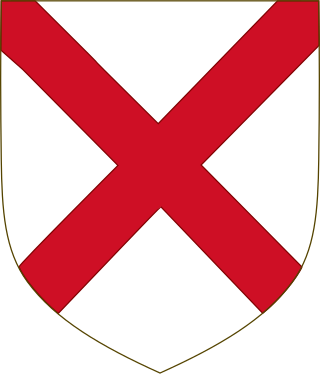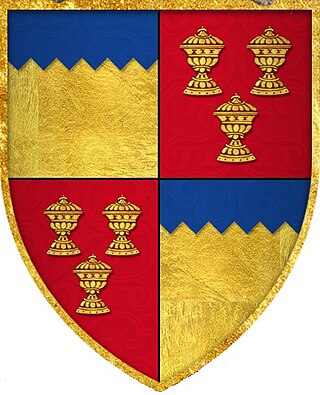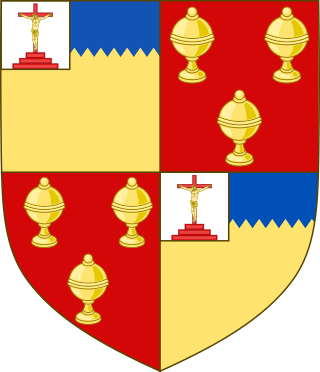Related Research Articles

Duke of Leinster is a title in the Peerage of Ireland and the premier dukedom in that peerage. The subsidiary titles of the Duke of Leinster are: Marquess of Kildare (1761), Earl of Kildare (1316), Earl of Offaly (1761), Viscount Leinster, of Taplow in the County of Buckingham (1747), Baron of Offaly, Baron Offaly (1620) and Baron Kildare, of Kildare in the County of Kildare (1870). The viscounty of Leinster is in the Peerage of Great Britain, the barony of Kildare in the Peerage of the United Kingdom, and all other titles in the Peerage of Ireland. The courtesy title of the eldest son and heir of the Duke of Leinster is Marquess of Kildare. The Duke of Leinster is the head of the House of Kildare.

Baron de Ros of Helmsley is the premier baron in the Peerage of England, created in 1288/89 for William de Ros, with precedence to 24 December 1264. Premier baron is a designation and status awarded to the holder of the most ancient extant barony of the Peerage of England. Before the Dissolution of the Monasteries the Prior of the Order of St John in England was deemed the premier baron.

Earl of Desmond is a title in the peerage of Ireland which has been created four times since 1329. The title was first awarded to Maurice FitzGerald, 4th Baron Desmond, a Hiberno-Norman lord in Southwest Ireland, and it was held by his descendants until 1583 when they rose against the English crown in the Desmond Rebellions. Following two short-lived recreations of the title in the early 1600s, the title has been held since 1628 by the Feilding family of Warwickshire, England. The current holder is Alexander Feilding, 12th Earl of Denbigh and 11th Earl of Desmond.

The FitzGerald dynasty is a Hiberno-Norman noble and aristocratic dynasty, originally of Cambro-Norman and Anglo-Norman origin. They have been peers of Ireland since at least the 13th century, and are described in the Annals of the Four Masters as having become "more Irish than the Irish themselves" or Gaels, due to assimilation with the native Gaelic aristocratic and popular culture. The dynasty has also been referred to as the Geraldines and Ireland's largest landowners. They achieved power through colonisation and the conquest of large swathes of Irish territory by the sons and grandsons of Gerald de Windsor. Gerald de Windsor was the first Castellan of Pembroke Castle in Wales, and became the male progenitor of the FitzMaurice and FitzGerald Dynasty. His father, Baron Walter FitzOther, was the first Constable and Governor of Windsor Castle for William the Conqueror, and was the Lord of 38 manors in England, making the FitzGeralds one of the "service families" on whom the King relied for his survival. Some of its members became the Black Knights, Green Knights and White Knights.

Piers Butler, 8th Earl of Ormond, 1st Earl of Ossory also known as Red Piers, was from the Polestown branch of the Butler family of Ireland. In the succession crisis at the death of Thomas Butler, 7th Earl of Ormond he succeeded to the earldom as heir male, but lost the title in 1528 to Thomas Boleyn. He regained it after Boleyn's death in 1538.

Maurice FitzThomas FitzGerald, 1st Earl of Desmond in Dublin Castle, Dublin, Ireland was an Irish nobleman in the Peerage of Ireland, Captain of Desmond Castle in Kinsale, so-called ruler of Munster, and for a short time Lord Justice of Ireland. Called "Maurice the Great", he led a rebellion against the Crown, but he was ultimately restored to favour.

Maurice FitzGerald, Lord of Maynooth, Naas, and Llanstephan (born: almost certainly not at Windsor Castle, more likely Carew in Wales c.1105 – September c.1176 Wexford, Ireland. He was a medieval Anglo-Norman baron and a major figure in the Norman Invasion of Ireland.
John FitzThomas was an Anglo-Norman in the Peerage of Ireland, as 4th Lord of Offaly from 1287 and subsequently as 1st Earl of Kildare from 1316.
Fitzmaurice is a Hiberno-Norman, Cambro-Norman, Anglo-Norman surname. It is patronymic as the prefix Fitz-
derives from the Latin filius, meaning "son of".

Henry O'Brien, 5th Earl of ThomondPC (Ire) (1588–1639), styled Lord Ibrickane until 1624, was summoned to the House of Lords of the Irish Parliament of 1613–1615.

Gerald FitzMaurice, jure uxoris 1st Lord of Offaly was a Cambro-Norman nobleman who took part with his father, Maurice FitzGerald, Lord of Llanstephan, in the Norman Invasion of Ireland (1169–71). Together with his five brothers and one sister Nesta they founded the notable FitzGerald/FitzMaurice dynasty which was to play an important role in Irish history.

Maurice FitzMaurice FitzGerald, 2nd Earl of Desmond was the son of Maurice FitzGerald, 1st Earl of Desmond, and his first wife, Catherine de Burgh.

Sir Theobald Butler, 1st Baron Cahir, Caher, or Cahier was the first baron Cahir of the second creation, which occurred in 1583.
Lettice FitzGerald, 1st Baroness Offaly was an Irish noblewoman and a member of the FitzGerald dynasty. Although she became heiress-general to the Earls of Kildare on the death of her father, the title instead went to the next FitzGerald male heir when her grandfather, the 11th Earl of Kildare, died in 1585. In 1620, she was created suo jure Baroness Offaly by King James I of England.

Thomas FitzJames FitzGerald, 7th Earl of Desmond, called 'Thomas of Drogheda', and also known as the Great Earl, was the son of James FitzGerald, 6th Earl of Desmond and Mary de Burgh. He was Lord Deputy of Ireland under the Lieutenancy of Duke of Clarence from 1463 to his death, and in 1464 founded the College of Youghal. His plan to found a University at Drogheda failed due to his judicial assassination.

John FitzThomas, 1st Baron Desmond was the son of Thomas Fitzmaurice, Lord OConnello by his wife Ellinor, daughter of Jordan de Marisco, and sister of Geoffrey de Marisco, who was appointed justiciar of Ireland in 1215. He was the grandson of Maurice FitzGerald, Lord of Lanstephan.

Thomas Fitzmaurice FitzGerald, 2nd Baron of Desmond, was the son of Maurice FitzJohn FitzGerald and grandson of John FitzThomas FitzGerald from whom he inherited the title.

Thomas FitzMaurice, Lord OConnello, of Shanid, was the eldest son of Maurice FitzGerald, Lord of Lanstephan by his wife, Alice. Thomas was the progenitor of the Geraldine House of Desmond, and brother of Gerald FitzMaurice, 1st Lord of Offaly, progenitor of the Geraldine Houses of Kildare and Leinster.

James fitz Maurice FitzGerald, de jure 12th Earl of Desmond, also counted 13th, was called Court Page as he grew up as a hostage for his grandfather Thomas FitzGerald, 11th Earl of Desmond, the Bald, at the court of Henry VIII. He should have succeeded this grandfather in 1534, but John FitzGerald, de facto 12th Earl of Desmond usurped the earldom and was followed in 1536 by his son James, fitz John. In 1539 the lord deputy of Ireland, Leonard Grey seized some Desmond land in southern County Cork and handed it to Court Page, who came to Ireland to claim his rights but was killed by Maurice fitz John FitzGerald, called Totane. He was succeeded by James fitz John, now rightful 13th earl.
Sir Robert Digby PC(I) was an English courtier who owned an estate at Coleshill, Warwickshire. His marriage to Lettice FitzGerald, heir-general to the 11th Earl of Kildare, led him to spend his life litigating over her claims to the Kildare lands. He divided his time between local business in Warwickshire and in Ireland.
References
- ↑ Cokayne, George Edward, ed. (1895). Complete peerage of England, Scotland, Ireland, Great Britain and the United Kingdom, extant, extinct or dormant (N to R). Vol. 6 (1st ed.). London: George Bell & Sons. p. 113. Retrieved 27 December 2011.
- ↑ Cokayne, George Edward, ed. (1890). Complete peerage of England, Scotland, Ireland, Great Britain and the United Kingdom, extant, extinct or dormant (D to F). Vol. 3 (1st ed.). London: George Bell & Sons. p. 358. Retrieved 27 December 2011.
- ↑ Note on earlier barony and "Offelan" by Goddard Henry Orpen. Offelan was also sometimes spelt Ophelan. The Uí Faelain were a branch of the former Gaelic-era Leinster dynasty
- ↑ Journal of the Co. Kildare Archaeological Soc, 1893, p.186 Online version here
- ↑ "Note on the O Conor Faly barony (published in 1914)". Archived from the original on 7 June 2010. Retrieved 27 May 2010.
- ↑ Lundy, Darryl. "p. 15487 § 154864". The Peerage.[ unreliable source ]
- ↑ Cokayne, George Edward, ed. (1892). Complete peerage of England, Scotland, Ireland, Great Britain and the United Kingdom, extant, extinct or dormant (G to K). Vol. 4 (1st ed.). London: George Bell & Sons. p. 368.
'